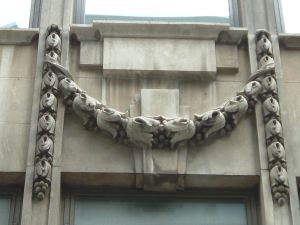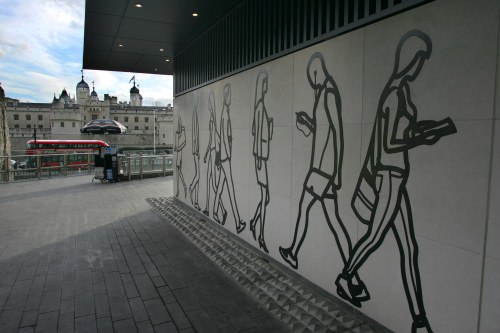Modern Stonemasonry
Contents |
[edit] CNC engineering and water jet cutting
The craft of stonemasonry has been around for millennia and natural stone is still quarried and fashioned into blocks or slabs in much the same sequence of events as before.
What has changed dramatically is the machinery used to fashion the stone. Hand skills such as polishing and carving are still used to finish the work where appropriate but now the bulk of the process is accomplished by machine.

Machined Portland Stone feature wall at Two New Ludgate
[edit] 3D rendering
Architectural models or scans of existing objects can be used to generate surface files that are then sent to a CNC-equipped cutting machine, such as the 5-axis machine installed by stoneCIRCLE which can be used to rough out and saw blocks, as well as shape, contour, engrave and polish them. This is very useful for the production of large monuments or replicating architectural details for restoration projects. The articles can then be finished by hand if necessary.

A 3D rendering of a column capital used to generate surface files


Machining Portland Stone swags for a restoration project and the finished swags in situ at 159 Fenchurch Street.

Susanna Heron's Jaumont Yellow Limestone frieze, Henslow's Walk

The limestone arch, altar, lectern, font and tabernacle were all produced using CNC-equipped cutting machines.
[edit] Water-jet cutting
Water-jet cutting allows intricate patterns to be cut into stone to create inlaid work for surfaces such as walls and floors and for pierced lattices and grills. It can also be used more creatively as is shown in artworks by Rhona Smith and Julian Opie where bronze is cut on the waterjet cutting machine before being patinated and then inserted into routed Portland Stone.

Tom Phillip's depiction of Tyburn Gallows in Westminster Cathedral is an example of waterjet cutting using several different marbles.

An Age, An Instant by Rhona Smith features waterjet cut bronze set in Portland Stone

Julian Opie's art installations for CitizenM Hotel, Tower of London and the Hamilton Princess Bermuda use the same technique.

This intricate floor was produced using marble cut on the waterjet cutter and then inlaid into a Nero Marquina marble base.
[edit] Stone: still relevant
As the case studies above show, natural stone is still a relevant material that can be used to create award-winning new architecture. The use of modern technology renders the process much less expensive and time-consuming than it once was and this is made easier still by the use of a stonemason based in the UK with all the advantages of language and proximity that that conveys.
--Stonecircle 11:36, 11 Sep 2018 (BST)
[edit] Related articles on Designing Buildings Wiki
- Building with structural stone.
- Types of stone.
- Choosing stone.
- Kentish ragstone.
- Limestone for building.
- Masonry.
- Iraq, Afghanistan, Gulf War Memorial
- Julian Opie Art Wall CitizenM Tower of London Hotel
- Two New Ludgate Portland Stone Feature Wall
- Use of Stone in Monks Lantern Weybridge
- Bookmatched Marble for Boutique Hotel
- Portland Stone.
- Sustainable stone.
- Julian Opie Limestone & Bronze Frieze for Bermuda Hotel
- Voussoir.
Featured articles and news
Homes England creates largest housing-led site in the North
Successful, 34 hectare land acquisition with the residential allocation now completed.
Scottish apprenticeship training proposals
General support although better accountability and transparency is sought.
The history of building regulations
A story of belated action in response to crisis.
Moisture, fire safety and emerging trends in living walls
How wet is your wall?
Current policy explained and newly published consultation by the UK and Welsh Governments.
British architecture 1919–39. Book review.
Conservation of listed prefabs in Moseley.
Energy industry calls for urgent reform.
Heritage staff wellbeing at work survey.
A five minute introduction.
50th Golden anniversary ECA Edmundson apprentice award
Showcasing the very best electrotechnical and engineering services for half a century.
Welsh government consults on HRBs and reg changes
Seeking feedback on a new regulatory regime and a broad range of issues.
CIOB Client Guide (2nd edition) March 2025
Free download covering statutory dutyholder roles under the Building Safety Act and much more.
Minister quizzed, as responsibility transfers to MHCLG and BSR publishes new building control guidance.
UK environmental regulations reform 2025
Amid wider new approaches to ensure regulators and regulation support growth.
BSRIA Statutory Compliance Inspection Checklist
BG80/2025 now significantly updated to include requirements related to important changes in legislation.






















